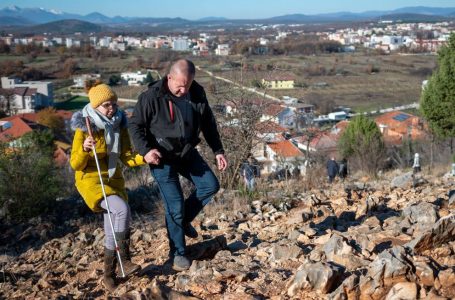
Profound prostration (Father Slavko Barbaric, OFM)
After the solemn singing of the preface, the faithful joyfully call out: “To HimWho comes”. He is blessed, sent by the Father. He is a saint. Hosanna is proclaimed to Him, which means that glory, honor and blessing belong to the Lamb Who comes to save people.
All this is actually a preparation for the glorious moment, which the faithful usually wait on their knees. It is then that the transformation takes place, when the priest, by the power of authority which is bestowed to him by priestly ordination, takes the bread and says the words of the High Priest from the Last Supper: “Take and eat this all of you: This is My Body, which will be given for you”. Then he takes the cup repeating also the words of Christ: “This is the cup of My Blood of the New and Eternal Covenant, which will be shed for you and for many for the forgiveness of sins”. The words with which Christ Himself gives power to His apostles to do the same thing are repeated: “Do this in remembrance of Me”.
These solemn and joyful moments are welcomed by the hearts of the faithful in a deep state of worship, mostly in deep silence and devotion. In front of this mystery, it is better to stay with the feeling of admiration and love with short greetings as long as a grateful heart, filled with love and the desire to meet, can express them.
Sometimes they sing something or exclaim hallelujah or something else appropriate, but they usually wait silently on their knees for the arrival and a new transformation. Each transformation is actually a new incarnation of the Word of God, which becomes living bread and divine drink for us the sinners.
I worship, believe and love You. I sincerely congratulate You, Savior. Welcome! WE PROCLAIM YOUR DEATH, LORD
After this transformation, the new transformation of the Son of God on the altar is pronounced by the priest : “The mystery of faith”. It is truly an unspeakable mystery. Our simple gifts of bread and wine became divine gifts by divine power. From this moment on Jesus is present in soul and body, divinity and humanity. Here His death and resurrection are reenacted and His coming is proclaimed. Therefore, the faithful respond with the cry: “We proclaim Your death, Lord Jesus, we confess Your resurrection and await Your coming in glory”.
The coming in question is the glorious coming of Jesus at the end of time. Thus, by accepting the Eucharist at this moment we touch death which is followed by resurrection, which announces the glorious coming of our life and the life of the whole community, the life of all humanity, which breaks the limit of the transience of death and already participates in eternal life. The transitory, limited, wounded and dead in and around us thus it becomes a place of encounter with eternal, imperishable and glorified life.
By proclaiming the death of Christ we, so to speak, practice death to sin and rise to a new and renewed life, to a better and more beautiful one daily. Fear disappears, the tombstone that closes life is rolled away, and life begins again. To overcome death already in this life means to have the strength to love and with love to sacrifice oneself for the sake of others. He who does not accept death is not able to live, and death will conquer and destroy him, and he will lose everything, he will live in constant fear and need to preserve his life. And whoever wants to save it will destroy it! However, he who wants to live freely in this world, with the freedom of God’s children, must conditionally view his death through the death of Christ, and thus he will receive his life again in the life of Christ and participate in His glorified eternity.
Therefore, the moment when we announce the death and resurrection of Christ should be a moment of special encouragement, joy and profound peace. With his death Jesus Christ overcomes our death and gives us new life. And that is why the Divine Liturgy becomes for us the Christians a constant renewal and openness to the life which every human heart strives for.










